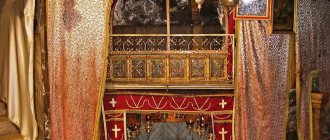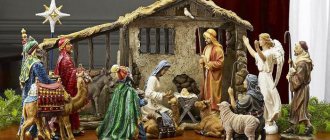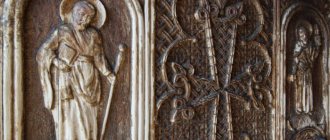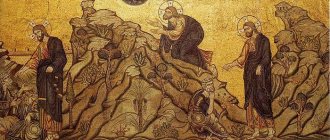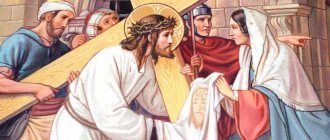| Savior Almighty. Icon of St. Andrei Rublev, 1410-20s. Collection Tretyakov Gallery |
Jesus Christ
,
the Son of God
,
God the Word
,
our Lord and Savior
, the Second Hypostasis of the Most Holy Trinity, according to the eternal advice of God, incarnated for the sake of the salvation of the sinful human race, from the Ever-Virgin Mary, voluntarily accepting suffering and death through crucifixion on the Cross, then resurrected and ascended to the Heaven to come again at the end of time, to judge the world and reign in eternity.
What does the name Jesus Christ mean?
The name of Jesus Christ carries the deepest meaning, being a kind of short symbol of the Christian faith. Jesus is a name, the Greek form of the Hebrew word "Yeshua", which means the help of God, or Savior. Christ is a title, a Greek word meaning “Anointed One”, in Hebrew it sounds like Mashiach - Messiah.
In ancient Israel, kings, high priests and prophets were called anointed, due to the fact that they were anointed for service with a special consecrated ointment. Through this sacred act, God's blessing was brought down upon man.
In carrying out His public ministry, Christ acted both as King, and as High Priest, and as Prophet. As a King, He exercised power over the elements, cast out demons, and performed signs and wonders. As a High Priest, he sacrificed himself on the Cross, and as a Prophet, he proclaimed the will of God, denounced evil, and initiated him into the secrets of the future. However, unlike the Old Testament anointed ones, Christ was anointed not with the material world, but directly with the Holy Spirit, and in Him dwelt “the fullness of the Godhead bodily” (Col. 2:9).
Christ
“Anointed” is how the title of Jesus is translated from Greek. But in Hebrew, the term “Mashiach” is associated with the honorary title of the Messiah. In the old days, a prophet or high priest could be called anointed. Kings were also designated by this word. The name is associated with the rite of anointing - covering the head of the chosen one with consecrated oil (chrism). This ritual action seemed to introduce Jesus to the great sacraments and service to the people of Israel.
Public ministry forced the Son of God to combine three roles - prophet, high priest and ruler. Jesus cast out demons, commanded the elements, performed miracles - this showed his royal essence. As the high priest, Christ sacrificed himself and was crucified. The prophetic hypostasis manifested itself in such a way that Jesus had to expose evil and communicate the divine will to people. However, no one anointed Christ with myrrh - in the literal sense of the word. They received a blessing from the Holy Spirit, who was sent to earth by God the Father.
Who is Jesus Christ?
1) Jesus Christ is the Son of God incarnate, one of the Persons of the Holy Trinity, God the Word. According to His Divine nature, the Son is born in eternity (outside the conditions of time) from God the Father (by analogy: just as a word is born from the mind, radiance from light, dew from fog).
In fulfillment of the will of the Father, the Son of God assumed human nature into His Hypostasis (1 John 4:9). The perception of human nature by God's Word occurred at the very moment of supernatural conception, in the womb of the Blessed Mary. Then the flesh of Jesus Christ, animated by the rational soul, received its existence. Thus, through the union of two natures, Divine and human, in one Person, the Son of God, without ceasing to be God, became a Perfect Man, like us in everything, with the exception of sin (Heb. 4:15).
The divine and human natures are united in the Hypostasis of Jesus Christ, unfused, immutable, inseparable and inseparable. This means that neither the Divine nor the human nature, as a result of the union, underwent the slightest change; they did not merge and did not form a new nature; will never separate. Since the Son of God is not only God, but also Man, He also possesses two wills: Divine and human. At the same time, His human will agrees with the Divine will in everything.
2) According to His human nature, Jesus Christ is the Son of the Most Holy Theotokos, a descendant of the king and prophet David. His conception took place without the participation of her husband’s seed and without violating the virginity of Mary, which She preserved both at the Birth and after the Birth of the Son.
Crucifixion
The next day, Jesus was brought before Pontius Pilate, the Roman governor of Judea. The priests accused Jesus of claiming to be king of the Jews and asked that he be sentenced to death. Pilate first tried to hand Jesus over to King Herod, but it failed, and Pilate told the Jewish priests that he could not find any guilt in Jesus. The priests reminded him that anyone who claims to be king is against Caesar. Pilate publicly washed his hands of responsibility, but ordered his crucification in response to the demands of the crowd. Roman soldiers put a crown of thorns on his head and led him to Golgotha.
Jesus was crucified with two thieves on his left and right. Over his head was a charge against him: Jesus of Nazareth, King of the Jews. At his feet stood his mother Mary and Mary Magdalene. While Jesus was on the cross, the sky darkened, and immediately after his death an earthquake occurred, tearing the veil of the temple from top to bottom. The soldier confirmed his death by stabbing him in the side with a spear. A few hours later He was taken down from the cross and buried in a nearby tomb.
Why did Christ appear?
As is known, the Good God “created man for incorruptibility and made him the image of His eternal existence” (Wis. 2:23). But man resisted the will of the Creator, and “sin entered into the world, and death through sin” (Rom. 5:12). As a result of the Fall, corruption affected not only the human conscience, but also the human essence itself. Man could no longer give birth to holy and sinless descendants; he became prone to evil, susceptible to the influence of fallen spirits: “Oh, what have you done, Adam? When you sinned, it was not only you who fell, but also us who come from you” (3 Ezra 7:48). The Fall “perverted all the powers of the soul, weakening its natural attractions to virtue” (St. Gregory of Sinai).
Man could only get rid of the power of sin only through the special intervention of Almighty God. And so, revealing His boundless love for mankind, God sends His Son into the world (John 3:16).
How did Christ deliver man from the power of sin, the corruption of death and the devil?
Coming out to preach at the age of thirty, Christ taught by word and example. Confirming His Divine mission and dignity, He more than once performed miracles and signs, including healings from illnesses and resurrections. The apogee of the ministry was the sacrifice of Himself on the Cross in atonement for sins: “He Himself bore our sins in His body on the tree, so that we, having been delivered from sins, would live for righteousness: by His stripes you were healed.” (1 Peter 2:24-25)
Having voluntarily accepted the Passion of the Cross and death, the Son of God descended in soul to hell, bound Satan, destroyed the souls of the righteous and, trampling death, was resurrected. Then He repeatedly appeared to His disciples and on the fortieth day He ascended to Heaven, paving the way to the Kingdom of God for all who would follow Him. On the Day of Pentecost, the Holy Spirit descended on the apostles, who has been continuously present in the Church since then. By joining the Church of Christ and living an active church life, a person draws closer to God, is sanctified, deified, and as a result is rewarded with eternal blissful life in Heaven.
Age of perfection 33 years
The age of Jesus at his crucifixion is not mentioned in the New Testament; only a solar eclipse is mentioned in the description of events. Astronomers studied the movements of the planets and calculated the date of Christ’s departure from earthly life. Luke wrote in his Gospel that the Savior began his ministry at the age of 30. Before that, he passed through three periods of life in the human body.
- Childhood under the patronage of the Virgin Mary, her care and teaching of everyday sciences.
- His adolescence was spent learning the craft of a carpenter, the basics of which were taught to him by his earthly father John, then by other masters of the city;
- Youth – mastering construction crafts, economics, finance and relationships between people.
From childhood, Jesus amazed everyone with his knowledge, ability to learn and ability to quickly master any profession. People admired his holiness and wisdom.
The age of 33 is considered the transition to maturity. Aging will begin later. Now maturity and self-awareness have come, the purpose of existence in this world.
The presence of the number 3 does not end there. Jesus died on Friday at 3 pm. The exact date has been determined - April 3.
INTERESTING: Orthodox cartoons.
How Christ confirmed that He is both God and Man
As God, Jesus Christ openly declares His Divine nature. He says: “He who has seen Me has seen the Father” (John 14:9), “I and the Father are one” (John 10:30), “no one knows the Son except the Father; and no one knows the Father except the Son, and to whom the Son wants to reveal it” (Matthew 11:27). To the question of the Jews, “Who are you?” He answers: “He was from the beginning, just as I told you” (John 8:25). Speaking to them about Abraham, He says: “Truly, truly, I say to you, before Abraham was, I am” (John 8:58).
But He also calls Himself the Son of Man. One can and should speak of Him as a man, with the exception of one difference - He is a perfect man, for He has no sin. The human nature of Jesus Christ is consubstantial with ours, but it is completely free from original sin. In Him human nature is again revealed in all its innocence and purity. His human nature is permeated by the Divine, transformed and completely unrelated to sin.
***
No one in the world has been spoken about as much as Jesus Christ.
Not a single person on earth has been or is being spoken about as much as is said about Jesus Christ. In each of the more than four million Christian churches and houses of worship, a sermon about Christ is heard. Professors from university departments talk about Him, students write essays about Him, they talk about Him, argue about Him, they admire Him, they criticize Him. The name of Jesus Christ has not left our lips for two thousand years; no other name on earth has been uttered so often.
There is not as much written about a single person as has been written and written about Jesus Christ. In addition to the Gospels, information about Him is contained in many other books, both fiction and scientific. They write about Him in newspapers and on the Internet; every year thousands of dissertations are defended in different countries on various aspects of His life or teachings.
There was no other person who had such a profound influence on the development of culture
There was no other person in history who had such a deep, comprehensive and fertilizing influence on the development of human culture. It was Jesus Christ who set the vector of cultural development of several continents for many centuries. Having begun in the Middle East, Christianity very quickly spread throughout Asia Minor and North Africa, then spread to Eastern and Western Europe. Subsequently, Christian civilization covered both Americas, Australia, a significant part of Africa and Southeast Asia. And in each of these regions, Christianity had a huge, in many cases decisive, influence on the development of culture and shaped the cultural codes of entire nations.
Not a single person in history can compare with Jesus Christ in the number of paintings dedicated to him. The total number of images of Christ placed in churches, including scenes from His life, amounts to tens of millions. Add to this all the works of world painting and sculpture dedicated to him, their numerous reproductions on postcards and albums - we can talk about billions of such images.
No single person has had so many pieces of music dedicated to him, from early Christian liturgical music to numerous cantatas and J. S. Bach's majestic Passion. The image of Jesus attracts composers from different countries, times and peoples.
Who are the Magi?
The word Magi is of Slavic origin; these are elders-sages, experienced people, they are also wanderers and sorcerers.
In the Western European tradition, the Star of Bethlehem was seen by three wise men, three kings, or kings, and three wizards, or magicians. Their names are not given in the Holy Scriptures.
The Orthodox Church does not consider the Magi to be either kings or magicians. And the number of wise men is not determined.
They are simply wise people who, having seen a new bright star in the sky, immediately guessed that the new King everyone was expecting had already been born.
This heavenly sign was given to them by the Lord himself. There is no magic here.
For the first time the Magi were called kings of Saint Caesarea by Arles. They even got names - Caspar, Melchior and Balthazar. They personified the kings of three different countries of the world.
The oldest among them, Balthazar, is a representative of the East, most likely from Africa, he has dark skin and white oriental clothes; Melchior is a mature man with white skin, he is from Europe; and Caspar is a black youth, a real Moor from Asia.
There is also an assumption that the Magi come from Persia, Arabia and Ethiopia.
Over time, different nations developed their own names for people who allegedly saw the Star of Bethlehem.
King Herod waited a long time for the Magi to appear. But they didn't come. Over time, he calmed himself with the thought that they had not found any newborn king, were ashamed of self-deception and returned home.
Only forty days later, the news spread throughout Jerusalem that Mary from Bethlehem had brought her newborn baby to the Jerusalem Temple, and Elder Simeon met her there and prophesied about the baby as Christ.
Having learned about this, Herod was beside himself with rage. He realized that the magicians had deceived him.
He called his main military leaders and gave them an order - to gather a detachment, go to Bethlehem and kill all the babies there aged two years and younger.
Not a single one will be left alive. He hoped that among them would be the future King of the Jews, the God-man Jesus Christ.
But the heavenly forces came to the defense of the born baby.
An angel of the Lord appeared in a dream to Joseph, Mary's husband, and told him to take his wife and baby and quickly go to Egypt, since King Herod learned about the birth of Jesus, they would look for the baby to kill.
Joseph took the most necessary things, saddled a donkey and, together with Mary and the baby, went to Egypt. Thus, Jesus' life was saved.
Simeon the God-Receiver. Artist V. K. Shebuev
Bethlehem. Artist V. D. Polenov
The influence of Jesus Christ on the moral condition of mankind is unprecedented
No person can be compared with Jesus Christ in terms of influence on the development of morality. Despite His complete absence of any traits of a social reformer, His teaching over the centuries became the cause of profound radical changes in the entire system of relationships between people, not only at the level of personal morality, but also at the social level. Let's give examples. Jesus did not call for the abolition of slavery, but it was because of the Christian understanding of the natural equality between people that slavery was eventually abolished. He did not call for a change in the political regime or reform of the legal code, but it was thanks to Christianity that the human community created those legal mechanisms that today underlie the life of many states. Jesus was not a fighter for social rights, but it is on Christian teaching that the understanding of human rights is based, which allowed women and children to become full members of society, allowed to eradicate inequality in public rights, discrimination on national and racial grounds and many other defects of the social structure characteristic of ancient world.
Human rights
We often hear about certain universal human values, which supposedly go back to a moral law common to all, and therefore are understandable to all people. But what are these values? And what is the role of Christianity in their affirmation?
...The idea of human rights - the cornerstone of the modern secular value system - in a certain sense grew out of Christianity. The idea that all people are endowed with equal rights by nature, which cannot be canceled by anything or anyone, did not come out of nowhere. It is largely based on the understanding of personality that was formed in Christianity. Why do people have rights at all? Because he is the image of God. From a Christian point of view, this is part of God’s plan for man: the individual is created, firstly, free, and secondly, with rights. Paradoxically, this is precisely why the fall of Adam and Eve became possible. If a person did not have rights, he would not be able to choose and would not choose the fruit from the forbidden tree of the knowledge of good and evil. And the second important message - that all people are equal - comes from the fact that everyone is equal before God. And they are equal not in their talents - here everyone is different - but precisely equal in rights before the Creator (the rich and healthy have no more rights to God's love than the poor and sick). So the idea of equality of rights appeared precisely in Christian culture.
Jesus Christ is fundamentally different from the prophets of other religions
Jesus Christ is the only Man whom many have revered as God incarnate for two thousand years. In many religious traditions, there are individuals who are revered as prophets or as great teachers (eg, Mohammed, Buddha, Confucius), but there is no other individual who is revered as God or prayed to as God.
There are many other examples of the influence of Jesus Christ on the development of human civilization in its most diverse aspects. But the examples given are quite enough to understand the reasons why the birth of this particular Man became the starting point in our calendar, and why He is the most famous Man in the entire history of mankind. On a global scale, Jesus Christ has no competitors in terms of the amount of influence he has on the minds and hearts of people, on their personal and social lives, on their ideological and moral attitudes.
***
The Holy Fathers of the IVth Council of Chalcedon, who gathered in 451 in the number of about 630 participants, defined the dogma about the image of the union in the Person of the Lord Jesus Christ of two natures in the following words:
“Following the Holy Fathers, we all unanimously teach to confess one and the same Son of our Lord Jesus Christ, perfect in Divinity and perfect in humanity, truly God and truly man, the same from the rational soul and body, consubstantial with the Father in Divinity, and the same consubstantial to us according to humanity, in everything like us except for sin, born before the ages from the Father according to Divinity, and in the last days for our sake and for the sake of salvation from Mary the Virgin Mother of God - according to humanity; one and the same Christ, the Son, the Lord, the only begotten, in two natures, unfused, unchangeably, inseparably, inseparably cognized - so that by the union the difference of the two natures is in no way violated, but all the more the property of each nature is preserved and united into one Person and one Hypostasis , - not into two persons cut or divided, but one and the same Son and Only Begotten, God the Word, the Lord Jesus Christ, as the prophets of ancient times taught about Him, and as the Lord Jesus Christ Himself taught us, and as the symbol of the fathers gave us.” .
Dogma of the One Hundred and Seventy Holy Fathers of the VI Ecumenical Council of Constantinople. About two wills and actions in our Lord Jesus Christ:
“We also preach, according to the teaching of the holy fathers, that in Him there are two natural wills or desires, and two natural actions, inseparably, unchangeably, inseparably, unmerged. And two natural desires are not opposed to one another, as the wicked heretics said - let it not be! But His human will does not contradict or oppose, but follows, or better said, submits to His Divine and omnipotent will.”
***
Stop talking about Christ. Start talking to Christ. Stop thinking of Christ as something external, distant. Find Him within yourself. Don’t invent Christ for yourself, let Him tell you about Himself. Don't try to save yourself. Let Him save you. He longs to care for you, to comfort you, to guide you; you just let Him do it by moving your self out of His way. All that is needed from you is just to look in His direction and whisper: “My Christ, save me.” Archpriest Sergius Baranov (Orsk)
Historical reference
The first mention of the city is found in the Amarna archive and dates back to 1350-30 BC. e. It was then in the possession of the Canaanites. According to the book of Kings, this is the birthplace and anointing of David. In this regard, the city is also called the city of David. And due to the fact that, according to the Gospel, this is the place where Jesus Christ was born, Christians consider it second in holiness, after Jerusalem.
In the 2nd century, during the Bar Kokhba revolt, Emperor Hadrian destroyed the city. Constantine the Great's mother, Empress Helena, contributed to his revival. In 327, she ordered the Church of the Nativity of Christ to be built here. In 529 the shrine was damaged by the Samaritans. They robbed her during the uprising. Later, Emperor Justinian I rebuilt the church.
In 637, Muslims conquered Bethlehem. Their rule lasted until the city was conquered by the Crusaders in 1099. They replaced the local Orthodox clergy with Latin ones. In the 13th century, the city walls were destroyed by the Mamluks and rebuilt in the 16th by the Ottomans. Power was transferred from the latter to the British after the 1st World War. In 1948, the city was occupied by Transjordan during the Arab-Israeli war. And later, in 1967, Israel, during the six-day war. According to the Oslo Accords, Bethlehem has been governed by the Palestinian Authority since 1995.
